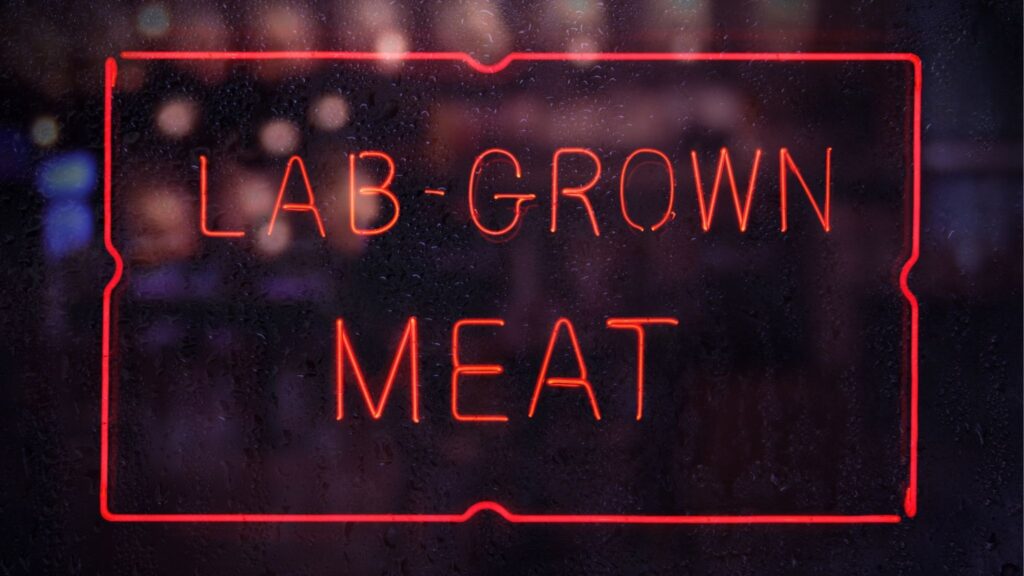Lab-grown meat represents one of the most radical innovations to reach our modern food systems.
Imagine a world in which we can create ‘real’ meat by growing animal cells in a controlled environment, bypassing the need to kill the animal who produced those cells.
Animal welfare would surely benefit – or would it? In a recent article I explored the potential for cultured meat to improve the welfare of our food-producing animals. The answer is not straightforward.

Nor is it clear that lab-grown meat can deliver on some of its other promises. Alongside animal welfare improvements, the environmental credentials of cultured meat have been amongst its most hyped potential benefits. Healthier meat products and improved food safety have also been promoted. In this article I focus on these issues.
Can lab-grown meat help fight climate change?
First, let’s look at the potential climate change-mitigating effects of lab-grown meat.
Agriculture is a major contributor to greenhouse gas (GHG) emissions globally. There are a few big sources of climate emissions in most of our modern diets. Livestock production is by far the largest.
Lab-grown meat promises an alternative that would reduce some of those emissions – particularly where they come from the release of nitrous oxide and methane. These gases are released when we grow crops and rear livestock.
Both of these GHGs occur through conventional meat production. Alongside CO2, they constitute the main greenhouse gases that we need to reduce to mitigate the impacts of climate change. Certainly, methane and nitrous oxide emissions from livestock production would go down where cultured meat replaces conventional. We wouldn’t need to produce so many plants to feed the animals and we wouldn’t need the animals themselves.
Some emissions are likely to go down, but others may increase
But the climate mitigating effects are at best uncertain. That’s because cultured meat production is a highly energy intensive process with consequent impacts in terms of CO2 emissions.
Some estimates suggest that when factoring in the relevant emissions, cultured meat production could have a GHG footprint that is much lower than that of beef – possibly more than 75% lower. But emissions could be the same or higher than for other animal products, such as chicken, pork and fish.
And when it comes to plants, there’s pretty much no comparison. Lab-grown meat could have a GHG footprint between 5 and 20 times higher than plant-based products like tofu, pulses and peas. Since GHGs from lab-grown meat largely result from industrial energy requirements, it’s possible that using renewable energy sources could greatly reduce those emissions – at least to make it competitive with conventional meat sources. That’s a big ‘if’.
Impacts on land and water use, as well as pollution, depend on the livestock system under comparison
The evidence on other environmental impacts from cultured meat production is also mixed. About a third of available fresh water and almost 80% of all agricultural land is used for livestock production. Producing meat in a lab should in theory require far less water and land than livestock production, regardless of how sustainable the conventional livestock practices are.
Where estimates rely on highly efficient production systems for lab-grown meat (e.g. using blue-green algae), land use requirements do seem to be lower for cultured meat. The results are more uncertain if conventional ‘feed’ inputs to lab-grown meat are used such as soy and corn. Land use is likely to be reduced overall when compared to livestock production, but some estimates suggest that land use is actually similar to poultry when the protein content is considered (due to the stocking densities of modern poultry production systems).
Water use is not clear-cut either. While it should be lower for lab-grown meat when compared to conventional – and estimates support this for beef, lamb and pork – it may be higher than for poultry production. Pollution could be reduced, for example, because less effluent flows into our rivers and oceans that can cause eutrophication and disrupt ecosystem functioning. Again, studies have indicated that this is likely to be the case for beef, lamb and pork, but not when compared to poultry.
Will cultured meat be healthier than conventional?
Health benefits are less often discussed but are an increasing part of the narrative from advocates of cultured meat.
Conventional meat offers some nutritional advantages over plants, including highly digestible proteins and easily absorbed vitamins and minerals that are critical to human health. But high consumption of red meat and processed meat products is associated with greater incidence of heart disease, stroke and some types of cancer. Cultured meat offers the possibility of having significant control over the factors that make (some types of) meat less healthy for us.
For one thing, the fat content of lab-grown meat can be manipulated. Beef, lamb and pork are all high in saturated fats, which contribute to cardiovascular disease and type 2 diabetes. These fats could be replaced with healthier omega-3 fatty acids, which have been shown to reduce the risk associated with heart disease and arthritis, as well as reduce inflammation.
Similarly, heme iron is found in meat (plants contain non-heme iron). Heme iron is readily absorbed in the body, helping to prevent iron deficiency. But heme iron has also been found to contribute to cardiovascular disease, some cancers and type 2 diabetes. Replacing this with non-heme iron (the kind that’s found in plants) could reduce these risks.
This is all theoretical, however. Lab-grown meat has not yet demonstrably provided all the beneficial nutrients found in conventional meat, nor has it yet been possible to create cultured meat that offers some of the healthier alternatives mentioned here.
The benefits of consuming, amongst other things, a low-fat, non-heme iron, and omega-3 rich diet have been demonstrated when found in their natural forms. There is far less and mostly inconclusive evidence of how this translates to health benefits, for example, when omega-3s are consumed as dietary supplements, or similarly when engineered into a new food product. This leaves a long hill to climb for cultured meat.
Food safety could be improved with lab-grown meat
Salmonella and Campylobacter infections in Europe alone were estimated to cost around 4 billion euro per year in 2010. A 2019 survey in the UK found that almost half of respondents reported that they had experienced food poisoning at some point in their lives. Our understanding of foodborne illness is only the ‘tip of the iceberg’ according to the World Health Organisation, because of challenges with monitoring their spread.
The sterile conditions in which lab-grown meat is produced would undoubtedly reduce the risks associated with foodborne illness such as Campylobacter, Salmonella and E. coli that arise from the conventional rearing and slaughter of livestock.
Another important consideration is antimicrobial resistance – the problem of disease-causing microbes no longer responding to the medicines developed to reduce and eliminate them. Antibiotics are used in large quantities in livestock production, including many that are also used to treat humans and some that are considered drugs of ‘last-resort’ in human medicine to treat multi-drug resistant infections when other antibiotics fail.
Although the excessive use and misuse of antibiotics for livestock production is increasingly being addressed at national and international levels, there is a long way to go. Antimicrobial resistance is now considered to be one of the leading threats to human health worldwide.
Producing cultured meat also requires the use of antibiotics, which are added to cell cultures to prevent infections. Because of the sterile conditions in which cultured meat is produced, it is expected that antibiotic use will be less than for conventional livestock production. Although at this stage it’s not clear what the ramifications of that usage may be and exactly how it compares to livestock production – especially when compared to conventional systems that have already greatly reduced the use of antibiotics.
As we live through a global pandemic, the problem of zoonoses – infectious diseases that can move from animals to humans – is also important to consider. Reducing the contact between humans and animals (e.g. at slaughter) would certainly reduce transmission of these diseases. Cultured meat offers that potential (although as with so many aspects of cultured meat, more research is needed).
What is the future for lab-grown meat?
Critically, we don’t know whether lab-grown meat would be a direct replacement for conventional. There is some evidence that meat consumption in high-income countries is plateauing. And as consumers become more aware of the impacts of a meat-heavy diet on our own health and on the planet, there may be a shift towards cultured meat as we’re starting to see with plant-based meat alternatives.
But meat consumption is still increasing in low- and middle-income countries. That could continue into the foreseeable future, largely offsetting many of the benefits from cultured meat. That’s a sobering thought.
To be fair, lab-grown meat is still at a relatively early stage of development. It’s not widely available to consumers and there are issues with producing it at the necessary scale. A limited number of studies have been done that can shed light on the issues raised in this article. Unless and until the sector evolves further and more data becomes available, it will be difficult to assess the trade-offs.
I write about the future of food and the connections between our food systems, the environment and public health. Sign up for my newsletter.
You can also read more here.






